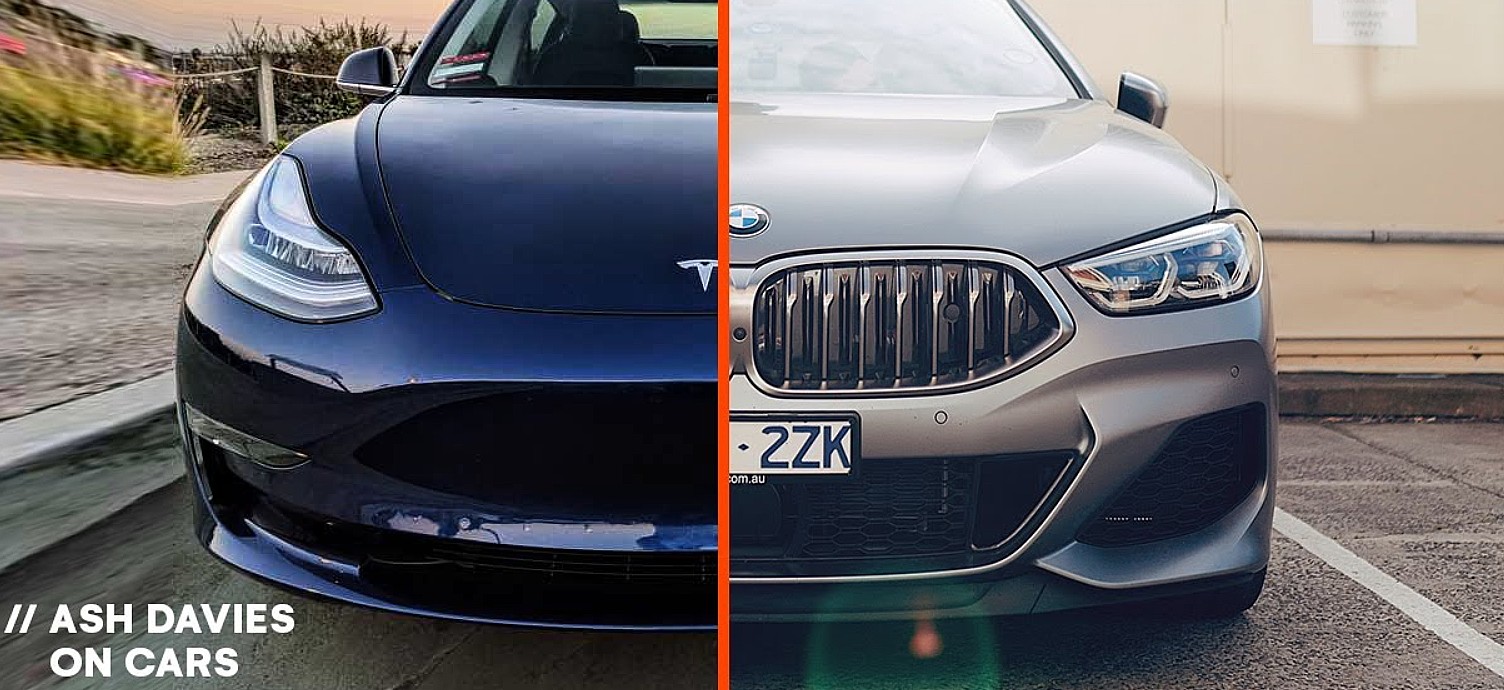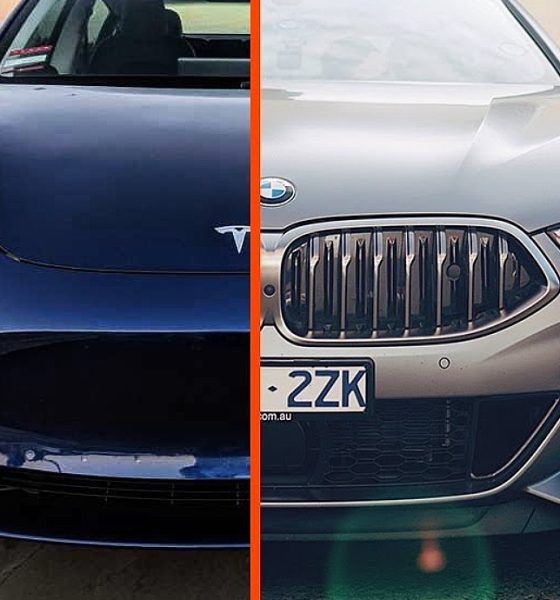

News
Tesla's free Autopilot battles BMW's best driver-assist tech in head-to-head test
A Tesla Model 3’s Standard Range Plus equipped with the company’s Autopilot feature was recently put to the test against a worthy competitor: the BMW M850i Gran Coupe, a car that combines luxury and performance with the German automaker’s own premium driver-assist software.
YouTube’s Ash Davies on Cars decided to compare the two vehicles and their respective driver-assist software as a way to see how one of the cheapest Tesla vehicles available would fare against the tech of one of the most luxurious and costly BMW vehicles that money could buy. The Model 3 was equipped with the company’s basic Autopilot, a feature that now comes standard on all of Tesla’s vehicles. This means the car was equipped with the ability to steer, accelerate, and brake for other vehicles and passengers in its lane.
The BMW M850i Gran Coupe, on the other hand, is equipped with an optional Driver Assistance Professional Package that gives drivers more awareness through a series of safety features like blind-spot notifications, cross-traffic alerts, lane-keeping steering assist and parking assistance. It also includes a feature that’s somewhat similar to Tesla Autopilot called Extended Traffic Jam Assistant, which helps the driver operate the vehicle in congested areas of the road.
Initially, Davies took the Model 3 out for a drive on his local freeway. Impressed by the vehicle’s ability to control and maneuver without incident, he stated he had no worries about the car driving itself, mostly due to the Driving Visualization feature available on the vehicle’s 15″ display screen. The reviewer noted that the Model 3’s basic Autopilot, while lacking the finer features found in Tesla’s Full Self-Driving suite, already behaves a lot like a human driver. The driver-assist system is also so refined that it’s very easy to trust Autopilot.
Davies then hopped in the six-figure BMW, explaining that the best tech of veteran car manufacturers are usually found in the top end models like the M805i Grand Coupe. While Davies took particular note of the vehicle’s luxurious features, he was not that impressed with the car’s actual tech. Even with its driver-assist feature active, for example, the vehicle’s display does not render any other cars on the road, unlike Tesla’s standard Autopilot.
He also notes that the Driver Assistance package is more like an adaptive cruise control than an Autopilot feature. After unsuccessfully attempting a lane change, Davies opted to test how well the vehicle stops when faced with traffic. The BMW slowed down, but it did so with such abruptness that the reviewer stated that “It slowed down with all the force of a car that thought it was about to have a crash.”
Tesla’s industry-leading Autopilot technology is one of many reasons the electric car maker continues to solidify its reputation as one the most innovative automotive company in the world. As told by Davies in his video, it is apparent Tesla’s Autopilot feature is easily outperforming the much more expensive features on a luxury car like a BMW. Perhaps, the reviewer noted, Tesla is simply a company that is very good with software while veteran automakers like BMW are good with hardware. And when it comes to driver-assist technology, the best software will likely win.
You can watch Ash Davies on Cars‘ comparison of Tesla’s Autopilot and BMW’s driver-assist features in the video below.

News
Tesla FSD fleet is nearing 7 billion total miles, including 2.5 billion city miles
As can be seen on Tesla’s official FSD webpage, vehicles equipped with the system have now navigated over 6.99 billion miles.

Tesla’s Full Self-Driving (Supervised) fleet is closing in on almost 7 billion total miles driven, as per data posted by the company on its official FSD webpage.
These figures hint at the massive scale of data fueling Tesla’s rapid FSD improvements, which have been quite notable as of late.
FSD mileage milestones
As can be seen on Tesla’s official FSD webpage, vehicles equipped with the system have now navigated over 6.99 billion miles. Tesla owner and avid FSD tester Whole Mars Catalog also shared a screenshot indicating that from the nearly 7 billion miles traveled by the FSD fleet, more than 2.5 billion miles were driven inside cities.
City miles are particularly valuable for complex urban scenarios like unprotected turns, pedestrian interactions, and traffic lights. This is also the difference-maker for FSD, as only complex solutions, such as Waymo’s self-driving taxis, operate similarly on inner-city streets. And even then, incidents such as the San Francisco blackouts have proven challenging for sensor-rich vehicles like Waymos.
Tesla’s data edge
Tesla has a number of advantages in the autonomous vehicle sector, one of which is the size of its fleet and the number of vehicles training FSD on real-world roads. Tesla’s nearly 7 billion FSD miles then allow the company to roll out updates that make its vehicles behave like they are being driven by experienced drivers, even if they are operating on their own.
So notable are Tesla’s improvements to FSD that NVIDIA Director of Robotics Jim Fan, after experiencing FSD v14, noted that the system is the first AI that passes what he described as a “Physical Turing Test.”
“Despite knowing exactly how robot learning works, I still find it magical watching the steering wheel turn by itself. First it feels surreal, next it becomes routine. Then, like the smartphone, taking it away actively hurts. This is how humanity gets rewired and glued to god-like technologies,” Fan wrote in a post on X.
News
Tesla starts showing how FSD will change lives in Europe
Local officials tested the system on narrow country roads and were impressed by FSD’s smooth, human-like driving, with some calling the service a game-changer for everyday life in areas that are far from urban centers.

Tesla has launched Europe’s first public shuttle service using Full Self-Driving (Supervised) in the rural Eifelkreis Bitburg-Prüm region of Germany, demonstrating how the technology can restore independence and mobility for people who struggle with limited transport options.
Local officials tested the system on narrow country roads and were impressed by FSD’s smooth, human-like driving, with some calling the service a game-changer for everyday life in areas that are far from urban centers.
Officials see real impact on rural residents
Arzfeld Mayor Johannes Kuhl and District Administrator Andreas Kruppert personally tested the Tesla shuttle service. This allowed them to see just how well FSD navigated winding lanes and rural roads confidently. Kruppert said, “Autonomous driving sounds like science fiction to many, but we simply see here that it works totally well in rural regions too.” Kuhl, for his part, also noted that FSD “feels like a very experienced driver.”
The pilot complements the area’s “Citizen Bus” program, which provides on-demand rides for elderly residents who can no longer drive themselves. Tesla Europe shared a video of a demonstration of the service, highlighting how FSD gives people their freedom back, even in places where public transport is not as prevalent.
What the Ministry for Economic Affairs and Transport says
Rhineland-Palatinate’s Minister Daniela Schmitt supported the project, praising the collaboration that made this “first of its kind in Europe” possible. As per the ministry, the rural rollout for the service shows FSD’s potential beyond major cities, and it delivers tangible benefits like grocery runs, doctor visits, and social connections for isolated residents.
“Reliable and flexible mobility is especially vital in rural areas. With the launch of a shuttle service using self-driving vehicles (FSD supervised) by Tesla in the Eifelkreis Bitburg-Prüm, an innovative pilot project is now getting underway that complements local community bus services. It is the first project of its kind in Europe.
“The result is a real gain for rural mobility: greater accessibility, more flexibility and tangible benefits for everyday life. A strong signal for innovation, cooperation and future-oriented mobility beyond urban centers,” the ministry wrote in a LinkedIn post.
News
Tesla China quietly posts Robotaxi-related job listing
Tesla China is currently seeking a Low Voltage Electrical Engineer to work on circuit board design for the company’s autonomous vehicles.

Tesla has posted a new job listing in Shanghai explicitly tied to its Robotaxi program, fueling speculation that the company is preparing to launch its dedicated autonomous ride-hailing service in China.
As noted in the listing, Tesla China is currently seeking a Low Voltage Electrical Engineer to work on circuit board design for the company’s autonomous vehicles.
Robotaxi-specific role
The listing, which was shared on social media platform X by industry watcher @tslaming, suggested that Tesla China is looking to fill the role urgently. The job listing itself specifically mentions that the person hired for the role will be working on the Low Voltage Hardware team, which would design the circuit boards that would serve as the nervous system of the Robotaxi.
Key tasks for the role, as indicated in the job listing, include collaboration with PCB layout, firmware, mechanical, program management, and validation teams, among other responsibilities. The role is based in Shanghai.
China Robotaxi launch
China represents a massive potential market for robotaxis, with its dense urban centers and supportive policies in select cities. Tesla has limited permission to roll out FSD in the country, though despite this, its vehicles have been hailed as among the best in the market when it comes to autonomous features. So far, at least, it appears that China supports Tesla’s FSD and Robotaxi rollout.
This was hinted at in November, when Tesla brought the Cybercab to the 8th China International Import Expo (CIIE) in Shanghai, marking the first time that the autonomous two-seater was brought to the Asia-Pacific region. The vehicle, despite not having a release date in China, received a significant amount of interest among the event’s attendees.








